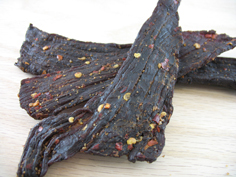
- Limited Time Offer

- Jerky News
- Jerky Recipes by Flavor
- Jerky Recipes by Meat
- Jerky Recipes by Method
- Jerky Making Info
Sandi’s Spicy Chicken Jerky Recipe

Ingredients:
- 1 lb. boneless chicken breast (or any meat type)
- 1/8 tsp. garlic powder
- 1/8 tsp. onion powder
- 1/4 tsp. white pepper
- 1/4 tsp. black pepper
- 1/2 tsp. cayenne pepper
- 1 tsp. crushed red pepper flakes
- 2 1/4 tsp. curing salt
- 2 1/4 tsp. pickling salt
Directions:
- Season meat and preheat oven to lowest temp.
- Cut meat into strips and reseason if you feel the need.
- Layout strips on foil covered cookie sheet, without touching, in oven for about 5 hours according to preference. Enjoy!
Get more recipes like this for FREE!
Do you want more recipes like this? Download our Beef Jerky Recipes ebook while it's FREE! But hurry...it's only free for a limited time!
Other Recipes You Might Enjoy
1 Response »
RSS feed for comments on this post. TrackBack URL
Leave a Response
We want to hear about your experiences with our Jerky Recipes! Please leave your comments on any recipe and help other jerky makers be successful. If you decide to buy Beef Jerky online, check out Jerky.com!
All salt, from one perspective, is “curing salt”. However, if, by “curing salt”, you mean pink “Prague Powder”…that is, true curing salt that contains 6.25% Sodium Nitrite, your jerky recipe will be adding something like 1800 part per million of nitrites to the jerky. When dehydrated and, say, 60% of the water weight of the raw chicken is driven off, the jerky will have something like 4500 ppm of nitrites. That is over 20 times the maximum allowed by the US FDA.
I don’t have a problem using “pink salt” for curing, since I am an amateur sausage-maker, and most sausage recipes (except for fresh Italian sausage, etc) call for it. But, I don’t exceed the gov. standards.
If you do mean true curing salt, one pound of raw chicken should have no more than about a quarter tsp of it.Your recipes could call for that, plus 2 tsp of kosher salt (which is non-iodized pure “table sale”). If, by curing salt, you meant just ordinary Sodium Chloride salt, you should just say “salt” or kosher salt. The reason for using kosher salt instead ot “table salt” in marinades, by the way, is that the iodine in the table salt can add an “off”, bitter, taste when a lot is used, such as in marinades. When shaken on food, it isn’t obvious.